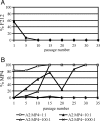In vitro and in vivo fitness of respiratory syncytial virus monoclonal antibody escape mutants
- PMID: 17005645
- PMCID: PMC1642624
- DOI: 10.1128/JVI.01387-06
In vitro and in vivo fitness of respiratory syncytial virus monoclonal antibody escape mutants
Abstract
Respiratory syncytial virus (RSV) is the only infectious disease for which a monoclonal antibody (MAb) is used in humans. Palivizumab (PZ) is a humanized murine MAb to the F protein of RSV. PZ-resistant viruses appear after in vitro and in vivo growth of RSV in the presence of PZ. Fitness for replication could be a determinant of the likelihood of dissemination of resistant viruses. We assessed the fitness of two PZ-resistant viruses (F212 and MP4). F212 grew less well in cell culture than the parent A2 virus and was predicted to be less fit than A2. Equal amounts of F212 and A2 were mixed and passaged in cell culture. F212 disappeared from the viral population, indicating it was less fit than the A2 virus. The MP4 virus grew as well as A2 in culture and in cotton rats. A2/MP4 virus input ratios of 1:1, 10:1, 100:1, and 1,000:1 were compared in competitive replication. For all input ratios except 1,000:1, the MP4 virus became dominant, supplanting the A2 virus. The MP4 virus also dominated the A2 virus during growth in cotton rats. Thus, the mutant MP4 virus was more fit than A2 virus in both in vitro and in vivo competitive replication. Whether this fitness difference was due to the identified nucleotide substitutions in the F gene or to mutations elsewhere in the genome is unknown. Understanding the mechanisms by which mutant virus fitness increased or decreased could prove useful for consideration in attenuated vaccine design efforts.
Figures




Similar articles
-
Variable resistance to palivizumab in cotton rats by respiratory syncytial virus mutants.J Infect Dis. 2004 Dec 1;190(11):1941-6. doi: 10.1086/425515. Epub 2004 Oct 27. J Infect Dis. 2004. PMID: 15529258
-
In vivo selection of respiratory syncytial viruses resistant to palivizumab.J Virol. 2005 Apr;79(7):3962-8. doi: 10.1128/JVI.79.7.3962-3968.2005. J Virol. 2005. PMID: 15767398 Free PMC article.
-
Respiratory syncytial virus escape mutant derived in vitro resists palivizumab prophylaxis in cotton rats.Virology. 2004 Jan 20;318(2):608-12. doi: 10.1016/j.virol.2003.10.018. Virology. 2004. PMID: 14972528
-
New strategies for control of respiratory syncytial virus infection.Curr Opin Infect Dis. 2008 Dec;21(6):639-43. doi: 10.1097/QCO.0b013e3283184245. Curr Opin Infect Dis. 2008. PMID: 18978532 Review.
-
2-5A antisense treatment of respiratory syncytial virus.Curr Opin Pharmacol. 2005 Oct;5(5):502-7. doi: 10.1016/j.coph.2005.05.003. Curr Opin Pharmacol. 2005. PMID: 16081320 Review.
Cited by
-
Initiating a watch list for Ebola virus antibody escape mutations.PeerJ. 2016 Feb 16;4:e1674. doi: 10.7717/peerj.1674. eCollection 2016. PeerJ. 2016. PMID: 26925318 Free PMC article.
-
Replication in the presence of dengue convalescent serum impacts Zika virus neutralization sensitivity and fitness.Front Cell Infect Microbiol. 2023 Mar 9;13:1130749. doi: 10.3389/fcimb.2023.1130749. eCollection 2023. Front Cell Infect Microbiol. 2023. PMID: 36968111 Free PMC article.
-
RSV Replication, Transmission, and Disease Are Influenced by the RSV G Protein.Viruses. 2022 Oct 29;14(11):2396. doi: 10.3390/v14112396. Viruses. 2022. PMID: 36366494 Free PMC article. Review.
-
RSM01, a novel respiratory syncytial virus monoclonal antibody: preclinical characterization and results of a first-in-human, randomised clinical trial.BMC Infect Dis. 2024 Dec 3;24(1):1378. doi: 10.1186/s12879-024-10120-w. BMC Infect Dis. 2024. PMID: 39627701 Free PMC article. Clinical Trial.
-
Escape from neutralization by the respiratory syncytial virus-specific neutralizing monoclonal antibody palivizumab is driven by changes in on-rate of binding to the fusion protein.Virology. 2014 Apr;454-455:139-44. doi: 10.1016/j.virol.2014.02.010. Epub 2014 Mar 3. Virology. 2014. PMID: 24725940 Free PMC article.
References
-
- Carman, W., A. Zanett, P. Karayiannis, J. Waters, G. Manzillo, E. Tanzi, A. Zuckerman, and H. Thomas. 1990. Vaccine-induced escape mutant of hepatitis B virus. Lancet 336:325-329. - PubMed
-
- Collins, P., R. Chanock, and B. Murphy. 2001. Respiratory syncytial virus, p. 1443-1485. In D. M. Knipe and P. M. Howley (ed.), Fields virology, 4th ed., vol. 1. Lippincot Williams & Wilkins, Philadelphia, Pa.
Publication types
MeSH terms
Substances
Grants and funding
LinkOut - more resources
Full Text Sources

